Fairhaven to Church Scar Coastal Protection Scheme (2018)
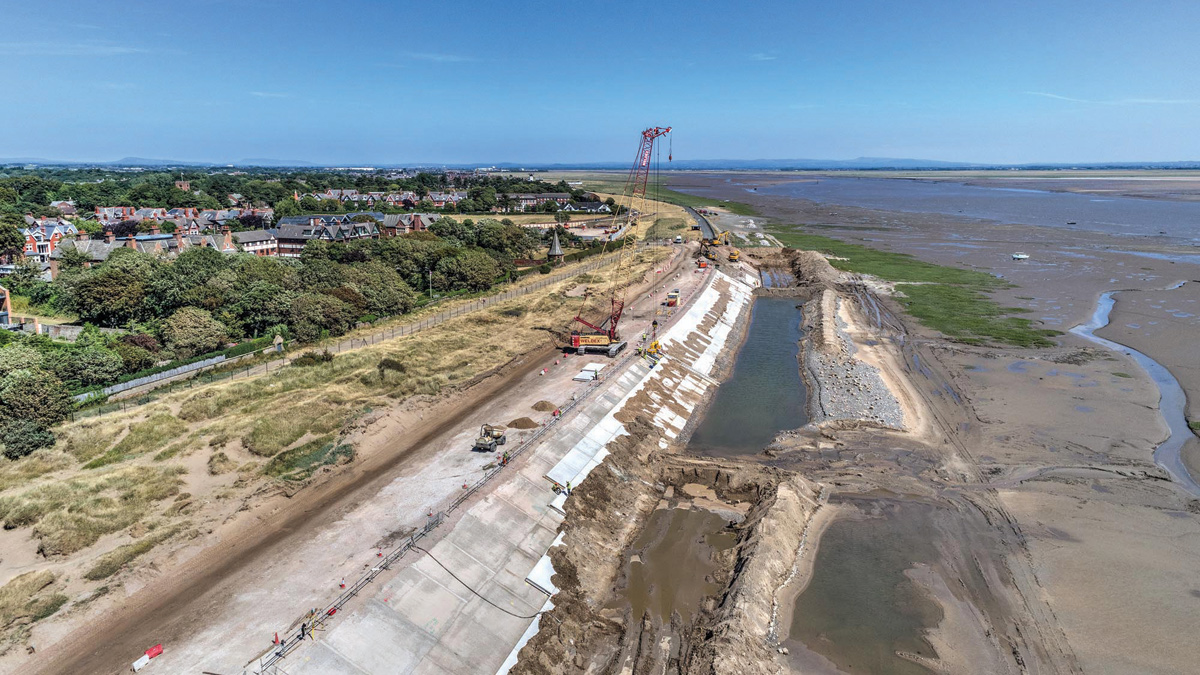
Aerial image of Church Scar revetment - Courtesy of Andy Torkington Photography
The town of Lytham St. Anne’s and its shoreline is a popular national and regional tourist destination and is linked to many attractions, modern and historic, including St. Anne’s Pier, Lytham Green, Royal Lytham Golf Club, Pleasure Island and Fairhaven Lake. The project is located near Lytham St. Anne’s in the Fylde borough of Lancashire, between Fairhaven and Seafield Road at Church Scar, which is approximately 2.5km of estuarine frontage. The existing sea wall comprises of 1890’s Victorian revetment defences and a promenade; all of which are in need of replacement to protect the 1,568 residential properties and 99 commercial properties at risk from coastal erosion. There are a further 1,670 residential and 72 commercial properties vulnerable from tidal inundation over the long term – a 1 in 100-year flood event.
Background of project
Over the past 10 years, Fylde Council has developed strategic studies and appraisal reports to secure funding to develop its 100-year management plan. This strategy is supported by its key partners, the Environment Agency (EA) and DEFRA. It is a key contributor to the national target to deliver better protection to 300,000 properties nationwide.
The existing headlands at Fairhaven and Church Scar are constantly undermined and require emergency repairs to prevent breaches from occurring. The project will also provide ongoing resilience to protect the town of Lytham.
Undertakings
VBA, a joint venture between VolkerStevin, Boskalis and SNC-Lavalin’s Atkins business, provided full design and build capabilities for the client. The Early Supplier Engagement (ESE) stage of the project was awarded to VBA by Fylde Borough Council in 2016.
In October 2017, VBA was appointed through the EA’s Water & Environmental Management (WEM) framework as main contractor, to undertake the £17.5m design and construct contract on behalf of the Council, with funding from the EA.
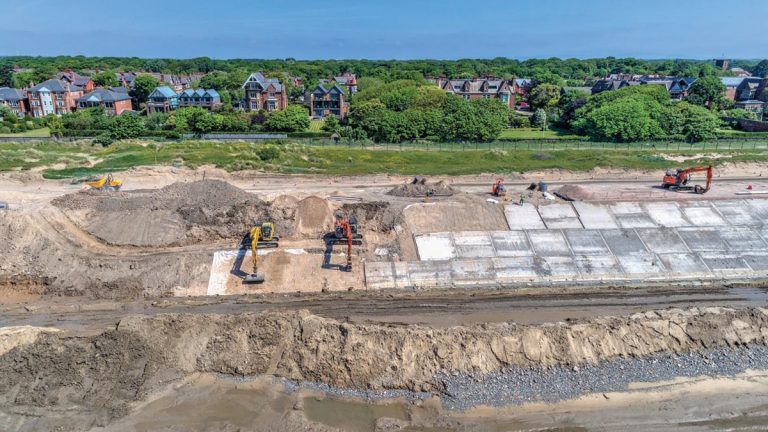
Church Scar revetment removal – Courtesy of Andy Torkington Photography
Key elements of the project and reason for the work
The Fairhaven to Church Scar Coastal Protection Scheme consists of two distinct phases:
- Phase 1 at Church Scar, which commenced on site in January 2018.
- Phase 2 at Fairhaven, which is expected to be completed in 2020.
The Church Scar phase replaces the existing stone pitched revetment, with the construction of piled cut-off structure and flat precast interlocking concrete units along approximately 0.9km length of the waterfront. The new revetment also includes periodic access steps to the beach, a new exposed aggregate feature promenade, new balustrade and improved lighting.
For the Fairhaven phase, a similar piled cut-off structure will be installed along with stepped precast (interlocking concrete units) for a length of approximately 1km around Fairhaven Lake. There will be matching access steps, a new exposed aggregate promenade, and lighting installed along the route, as well as car parking and public realm improvements.
One of the key requirements of the scheme is to ensure, when the existing revetment is removed, that all of the voids beneath are identified and filled prior to the new precast units being installed. VBA’s proposal included removing the existing stone pitching using an earthworks method which fully dealt with the voids issue.
The existing revetment has been processed to a suitable fill material and re-incorporated into the works, minimising disposal and transportation costs.
Project design
VolkerStevin is leading the main construction works and its design partners, Atkins, carried out the detailed design phase. VolkerStevin appointed a dedicated design manager to interface with Atkins to help facilitate and log ideas between the construction and design teams. VBA ensured continuity of the team from the ESE stage by retaining existing knowledge and overseeing the design approval process, to allow a quick start to the construction phase.
The design consists of precast concrete revetment panels, supported by a steel pile retaining wall at the toe of the revetment. For the duration of the project at Church Scar and Fairhaven, the steel pile retaining wall is a combi-wall with circular hollow section piles, spaced by three AZ sheet piles. This efficient design, developed by in-house piling specialists VolkerGround Engineering, protects the revetment from scour and minimises the amount of steel required.
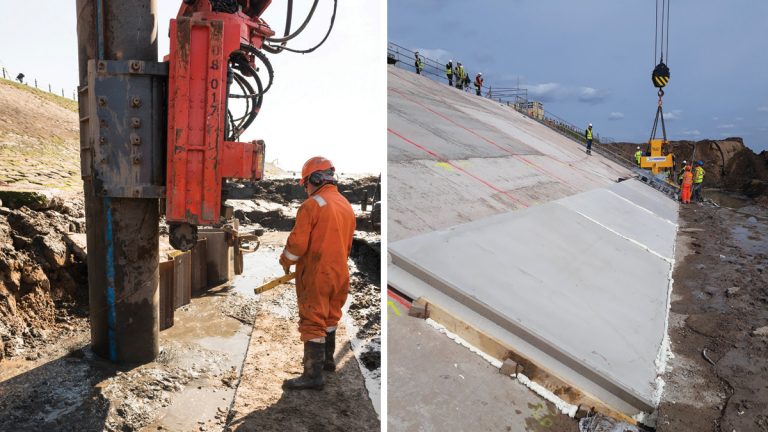
(left) Installation of combi-wall to toe piles – Courtesy of Karen Wright Photography Ltd and (right) Church Scar bottom row of revetment units – Andy Torkington Photography
Precast concrete
The Fairhaven Costal Protection scheme also requires precast concrete revetment units to protect the coastline and provide a 1 in 100 year flood defence. In the first phase, Church Scar will use around 1,100 precast concrete units, with a further 2,000+ in the second phase at Fairhaven.
VBA’s strategic supply chain partner, Moore Concrete Products, has worked closely with Atkins on the design parameters, concrete mix options and optimum sizing of the units which are produced in Moore’s Northern Ireland factory. One of the key benefits of the design development stage was achieving design approval to use fibre reinforced concrete to speed up the production process and reduce the amount of work in each unit.
The units, each weighing up to 10 tonnes, are supported on a sloped formation – Church Scar is 1 in 2, and Fairhaven, is 1 in 2.7.
An issue on a previous phase in the area was the build-up of pour pressure behind the units as the tide receded. This was addressed by the designers using a 200mm drainage layer on top of the new fill material and under the blinding concrete. This linked to a no-fines concrete toe beam by the piles, to allow the water to escape.
Promenade
To complete the works, a minimum 5.5m wide promenade will feature at the top of the revetment with an exposed aggregate finish. Associated street lighting and furniture will be installed to create a safe public space.
At Fairhaven Lake, to encourage social use of the area, the revetment will be stepped and built without access restricted handrails to allow people easy entry to the beach.
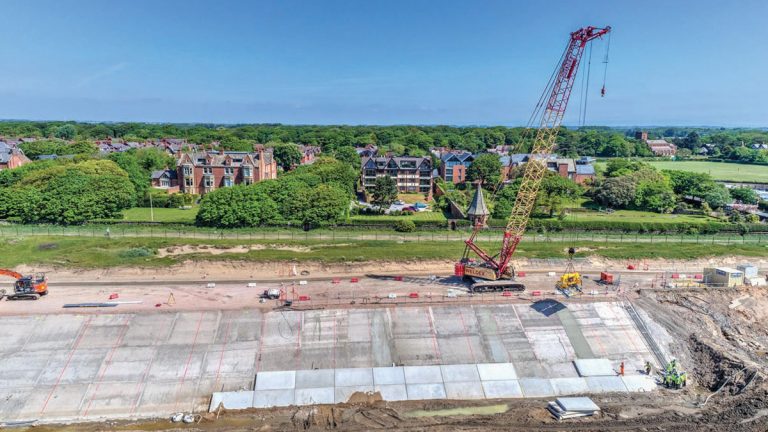
Church Scar bottom new revetment unit installation – Andy Torkington Photography
LEAN exercise
Before construction started, a detailed LEAN exercise was carried out to review the number of units per day to be placed and how this could be improved upon. The ‘hang time’ of the units on the 130T crane were key to improving daily outputs.
Alternative installation options were considered and trialled, including the use of adjustable air bags under the units, so final line and level could be achieved while the next unit was being picked up by the crane. The LEAN process also looked at the transportation issues in placing the units in the right order from Ireland to Fairhaven on a daily basis, while considering weather implications for the ferry crossings and crane usage on site.
Once installation had started on site, a time and motion study was carried out to identify other potential blockers so these could be addressed. The next key issue was the supply and delivery times for the grout to be placed under the units, which has subsequently been addressed. By using LEAN techniques in conjunction with our weekly collaborative planning sessions, we have been able to nearly double our tender output projections for the Church Scar section of the project.
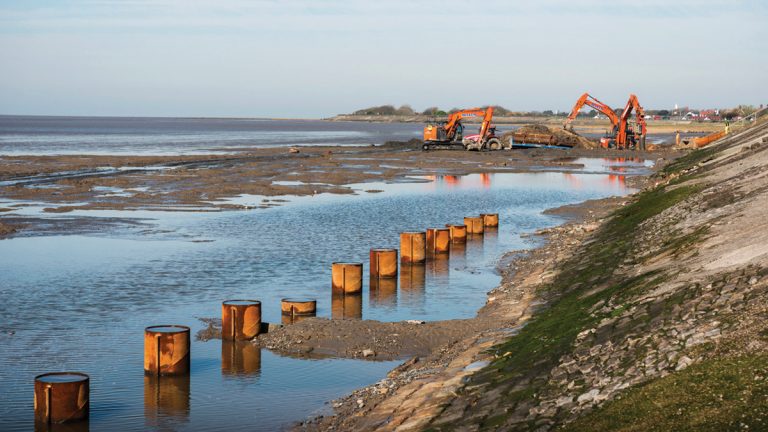
Excavation works to the toe piles – Courtesy of Karen Wright Photography Ltd
Customer experience
Delivering major work in a close knit community demands empathy and continuous communication. The project is located in an area populated with walkers, cyclists and bird watchers, meaning that high levels of public engagement from the outset has been crucial to the success of the project.
A successful pre-start public exhibition was held with almost 200 attendees. This gave the project team the opportunity to introduce themselves to the community, discuss the plans, and advise local residents on how VBA will seek to mitigate impacts caused by the work.
A dedicated customer drop-in centre is located on-site for the duration of the project, allowing the community to see how the project is progressing. Regular letters have been sent to the surrounding community updating residents on progress and advising them of short-term impacts caused by VBA’s activities. A subscriber list has also been created for email updates, with the aim of reaching tourists as well as local residents.
The project team also assist a local volunteer group, ‘Friends of the Estuary’, in cleaning the beach, with the view that the area should provide a clean, safe and welcoming environment for birds, marine life, animals, residents and visitors.
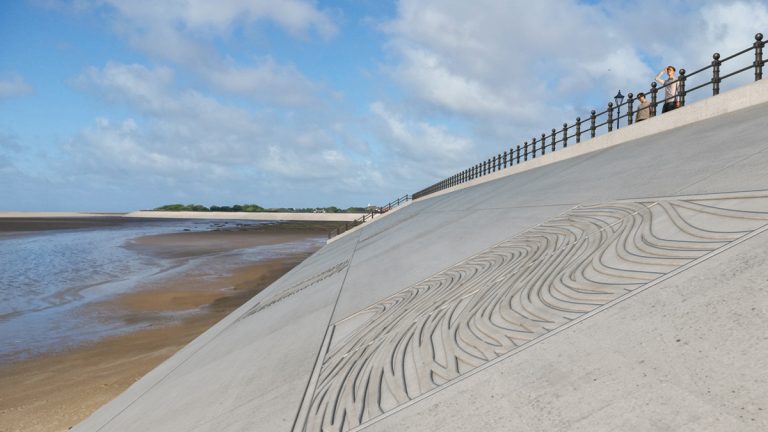
Church Scar revetment – Courtesy of Fylde Council
Progress
Phase 1 of the Church Scar project is due for completion in 2018 and phase 2 at Fairhaven in 2020. To date Church Scar is ahead of programme and VBA has been able to start the Fairhaven section early by agreement with Fylde Borough Council.
VBA is the senior supplier and a project board member and along with the EA, has assisted the project executive (Fylde Council) in governing the project in the PRINCE2 environment.
The scheme will prevent flooding in the town for 100 years as part of Fylde Council’s management plan, protecting over 2,000 properties and businesses.



